Zhengxia Zou
University of Michigan
FoBa: A Foreground-Background co-Guided Method and New Benchmark for Remote Sensing Semantic Change Detection
Sep 19, 2025Abstract:Despite the remarkable progress achieved in remote sensing semantic change detection (SCD), two major challenges remain. At the data level, existing SCD datasets suffer from limited change categories, insufficient change types, and a lack of fine-grained class definitions, making them inadequate to fully support practical applications. At the methodological level, most current approaches underutilize change information, typically treating it as a post-processing step to enhance spatial consistency, which constrains further improvements in model performance. To address these issues, we construct a new benchmark for remote sensing SCD, LevirSCD. Focused on the Beijing area, the dataset covers 16 change categories and 210 specific change types, with more fine-grained class definitions (e.g., roads are divided into unpaved and paved roads). Furthermore, we propose a foreground-background co-guided SCD (FoBa) method, which leverages foregrounds that focus on regions of interest and backgrounds enriched with contextual information to guide the model collaboratively, thereby alleviating semantic ambiguity while enhancing its ability to detect subtle changes. Considering the requirements of bi-temporal interaction and spatial consistency in SCD, we introduce a Gated Interaction Fusion (GIF) module along with a simple consistency loss to further enhance the model's detection performance. Extensive experiments on three datasets (SECOND, JL1, and the proposed LevirSCD) demonstrate that FoBa achieves competitive results compared to current SOTA methods, with improvements of 1.48%, 3.61%, and 2.81% in the SeK metric, respectively. Our code and dataset are available at https://github.com/zmoka-zht/FoBa.
LatticeWorld: A Multimodal Large Language Model-Empowered Framework for Interactive Complex World Generation
Sep 05, 2025Abstract:Recent research has been increasingly focusing on developing 3D world models that simulate complex real-world scenarios. World models have found broad applications across various domains, including embodied AI, autonomous driving, entertainment, etc. A more realistic simulation with accurate physics will effectively narrow the sim-to-real gap and allow us to gather rich information about the real world conveniently. While traditional manual modeling has enabled the creation of virtual 3D scenes, modern approaches have leveraged advanced machine learning algorithms for 3D world generation, with most recent advances focusing on generative methods that can create virtual worlds based on user instructions. This work explores such a research direction by proposing LatticeWorld, a simple yet effective 3D world generation framework that streamlines the industrial production pipeline of 3D environments. LatticeWorld leverages lightweight LLMs (LLaMA-2-7B) alongside the industry-grade rendering engine (e.g., Unreal Engine 5) to generate a dynamic environment. Our proposed framework accepts textual descriptions and visual instructions as multimodal inputs and creates large-scale 3D interactive worlds with dynamic agents, featuring competitive multi-agent interaction, high-fidelity physics simulation, and real-time rendering. We conduct comprehensive experiments to evaluate LatticeWorld, showing that it achieves superior accuracy in scene layout generation and visual fidelity. Moreover, LatticeWorld achieves over a $90\times$ increase in industrial production efficiency while maintaining high creative quality compared with traditional manual production methods. Our demo video is available at https://youtu.be/8VWZXpERR18
RSRefSeg 2: Decoupling Referring Remote Sensing Image Segmentation with Foundation Models
Jul 08, 2025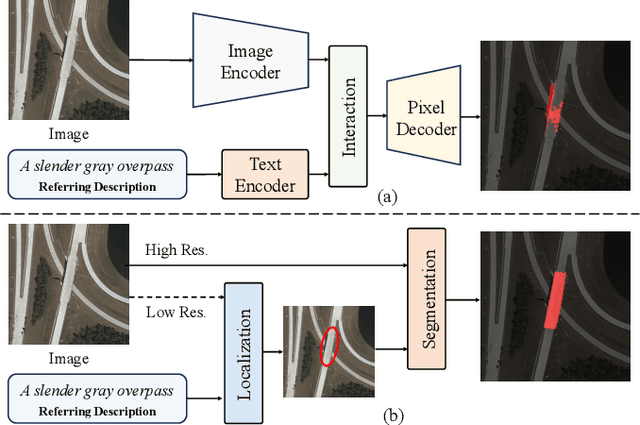
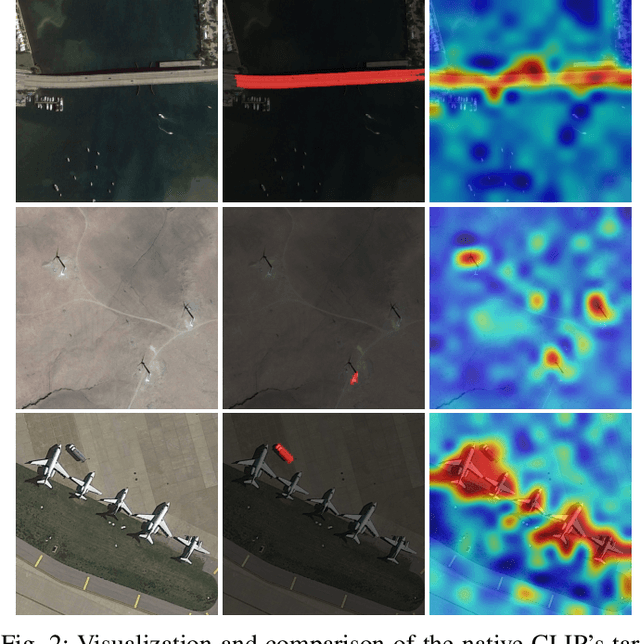
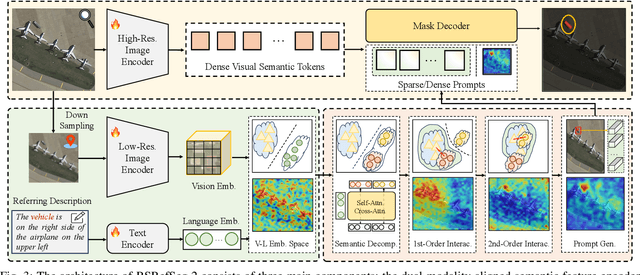
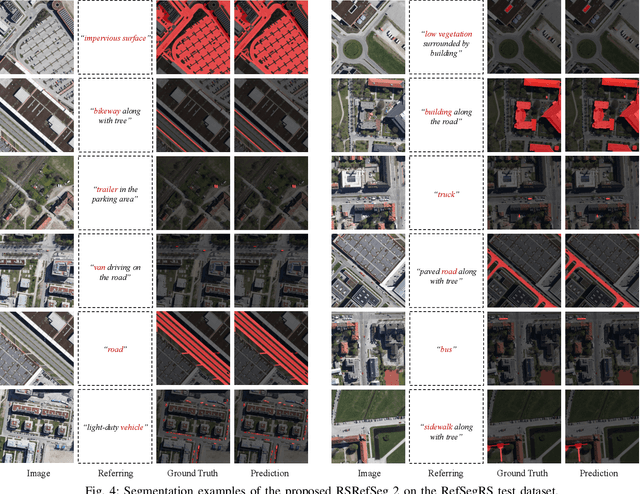
Abstract:Referring Remote Sensing Image Segmentation provides a flexible and fine-grained framework for remote sensing scene analysis via vision-language collaborative interpretation. Current approaches predominantly utilize a three-stage pipeline encompassing dual-modal encoding, cross-modal interaction, and pixel decoding. These methods demonstrate significant limitations in managing complex semantic relationships and achieving precise cross-modal alignment, largely due to their coupled processing mechanism that conflates target localization with boundary delineation. This architectural coupling amplifies error propagation under semantic ambiguity while restricting model generalizability and interpretability. To address these issues, we propose RSRefSeg 2, a decoupling paradigm that reformulates the conventional workflow into a collaborative dual-stage framework: coarse localization followed by fine segmentation. RSRefSeg 2 integrates CLIP's cross-modal alignment strength with SAM's segmentation generalizability through strategic foundation model collaboration. Specifically, CLIP is employed as the dual-modal encoder to activate target features within its pre-aligned semantic space and generate localization prompts. To mitigate CLIP's misactivation challenges in multi-entity scenarios described by referring texts, a cascaded second-order prompter is devised, which enhances precision through implicit reasoning via decomposition of text embeddings into complementary semantic subspaces. These optimized semantic prompts subsequently direct the SAM to generate pixel-level refined masks, thereby completing the semantic transmission pipeline. Extensive experiments (RefSegRS, RRSIS-D, and RISBench) demonstrate that RSRefSeg 2 surpasses contemporary methods in segmentation accuracy (+~3% gIoU) and complex semantic interpretation. Code is available at: https://github.com/KyanChen/RSRefSeg2.
SeG-SR: Integrating Semantic Knowledge into Remote Sensing Image Super-Resolution via Vision-Language Model
May 29, 2025Abstract:High-resolution (HR) remote sensing imagery plays a vital role in a wide range of applications, including urban planning and environmental monitoring. However, due to limitations in sensors and data transmission links, the images acquired in practice often suffer from resolution degradation. Remote Sensing Image Super-Resolution (RSISR) aims to reconstruct HR images from low-resolution (LR) inputs, providing a cost-effective and efficient alternative to direct HR image acquisition. Existing RSISR methods primarily focus on low-level characteristics in pixel space, while neglecting the high-level understanding of remote sensing scenes. This may lead to semantically inconsistent artifacts in the reconstructed results. Motivated by this observation, our work aims to explore the role of high-level semantic knowledge in improving RSISR performance. We propose a Semantic-Guided Super-Resolution framework, SeG-SR, which leverages Vision-Language Models (VLMs) to extract semantic knowledge from input images and uses it to guide the super resolution (SR) process. Specifically, we first design a Semantic Feature Extraction Module (SFEM) that utilizes a pretrained VLM to extract semantic knowledge from remote sensing images. Next, we propose a Semantic Localization Module (SLM), which derives a series of semantic guidance from the extracted semantic knowledge. Finally, we develop a Learnable Modulation Module (LMM) that uses semantic guidance to modulate the features extracted by the SR network, effectively incorporating high-level scene understanding into the SR pipeline. We validate the effectiveness and generalizability of SeG-SR through extensive experiments: SeG-SR achieves state-of-the-art performance on two datasets and consistently delivers performance improvements across various SR architectures. Codes can be found at https://github.com/Mr-Bamboo/SeG-SR.
BlockGaussian: Efficient Large-Scale Scene Novel View Synthesis via Adaptive Block-Based Gaussian Splatting
Apr 15, 2025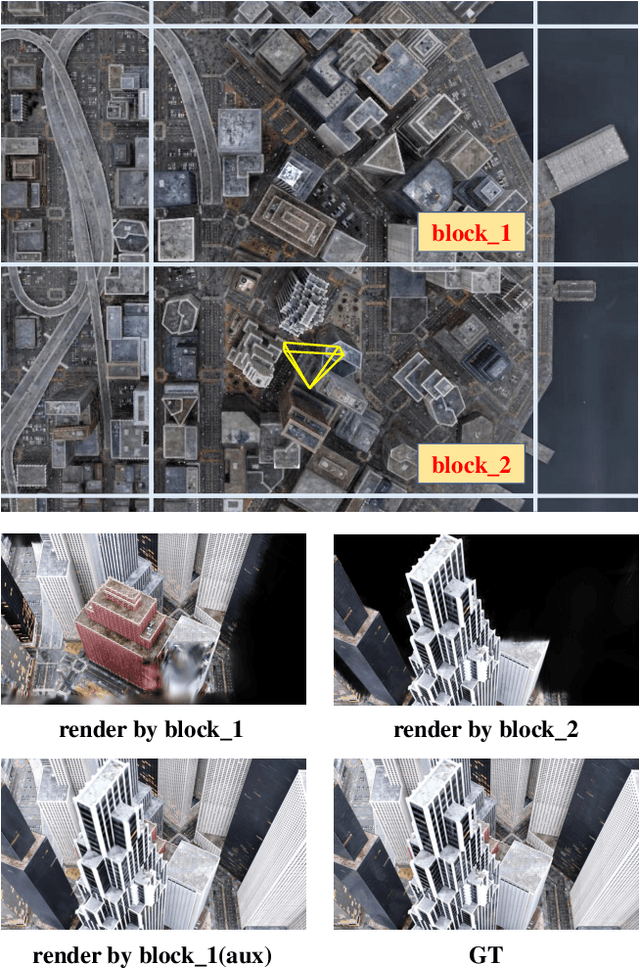
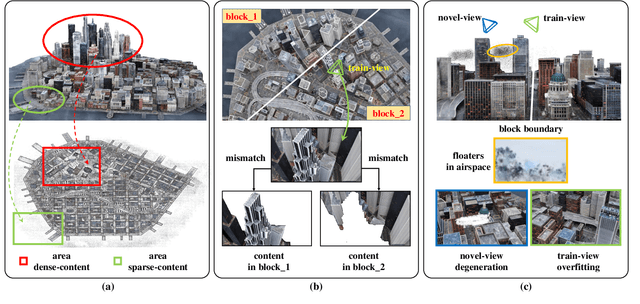
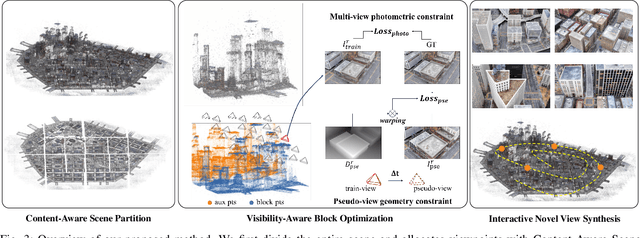
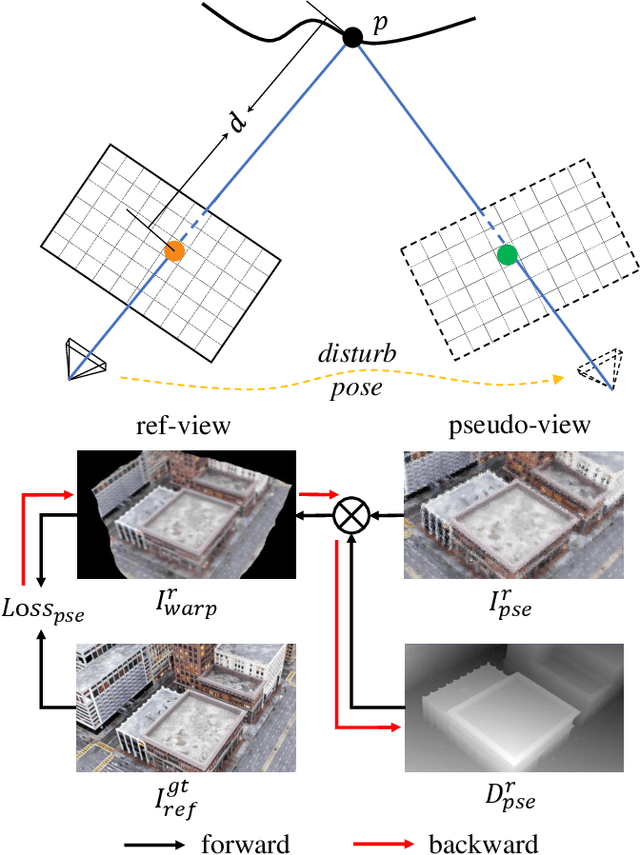
Abstract:The recent advancements in 3D Gaussian Splatting (3DGS) have demonstrated remarkable potential in novel view synthesis tasks. The divide-and-conquer paradigm has enabled large-scale scene reconstruction, but significant challenges remain in scene partitioning, optimization, and merging processes. This paper introduces BlockGaussian, a novel framework incorporating a content-aware scene partition strategy and visibility-aware block optimization to achieve efficient and high-quality large-scale scene reconstruction. Specifically, our approach considers the content-complexity variation across different regions and balances computational load during scene partitioning, enabling efficient scene reconstruction. To tackle the supervision mismatch issue during independent block optimization, we introduce auxiliary points during individual block optimization to align the ground-truth supervision, which enhances the reconstruction quality. Furthermore, we propose a pseudo-view geometry constraint that effectively mitigates rendering degradation caused by airspace floaters during block merging. Extensive experiments on large-scale scenes demonstrate that our approach achieves state-of-the-art performance in both reconstruction efficiency and rendering quality, with a 5x speedup in optimization and an average PSNR improvement of 1.21 dB on multiple benchmarks. Notably, BlockGaussian significantly reduces computational requirements, enabling large-scale scene reconstruction on a single 24GB VRAM device. The project page is available at https://github.com/SunshineWYC/BlockGaussian
DynamicVis: An Efficient and General Visual Foundation Model for Remote Sensing Image Understanding
Mar 20, 2025Abstract:The advancement of remote sensing technology has improved the spatial resolution of satellite imagery, facilitating more detailed visual representations for diverse interpretations. However, existing methods exhibit limited generalization capabilities across varied applications. While some contemporary foundation models demonstrate potential, they are hindered by insufficient cross-task adaptability and primarily process low-resolution imagery of restricted sizes, thus failing to fully exploit high-resolution data or leverage comprehensive large-scene semantics. Crucially, remote sensing imagery differs fundamentally from natural images, as key foreground targets (eg., maritime objects, artificial structures) often occupy minimal spatial proportions (~1%) and exhibit sparse distributions. Efficiently modeling cross-task generalizable knowledge from lengthy 2D tokens (~100,000) poses a significant challenge yet remains critical for remote sensing image understanding. Motivated by the selective attention mechanisms inherent to the human visual system, we propose DynamicVis, a dynamic visual perception foundation model for remote sensing imagery. The framework integrates a novel dynamic region perception backbone based on the selective state space model, which strategically balances localized detail extraction with global contextual integration, enabling computationally efficient encoding of large-scale data while maintaining architectural scalability. To enhance cross-task knowledge transferring, we introduce a multi-instance learning paradigm utilizing meta-embedding representations, trained on million-scale region-level annotations. Evaluations across nine downstream tasks demonstrate the model's versatility. DynamicVis achieves multi-level feature modeling with exceptional efficiency, processing (2048x2048) pixels with 97 ms latency (6% of ViT's) and 833 MB GPU memory (3% of ViT's).
TriDF: Triplane-Accelerated Density Fields for Few-Shot Remote Sensing Novel View Synthesis
Mar 17, 2025Abstract:Remote sensing novel view synthesis (NVS) offers significant potential for 3D interpretation of remote sensing scenes, with important applications in urban planning and environmental monitoring. However, remote sensing scenes frequently lack sufficient multi-view images due to acquisition constraints. While existing NVS methods tend to overfit when processing limited input views, advanced few-shot NVS methods are computationally intensive and perform sub-optimally in remote sensing scenes. This paper presents TriDF, an efficient hybrid 3D representation for fast remote sensing NVS from as few as 3 input views. Our approach decouples color and volume density information, modeling them independently to reduce the computational burden on implicit radiance fields and accelerate reconstruction. We explore the potential of the triplane representation in few-shot NVS tasks by mapping high-frequency color information onto this compact structure, and the direct optimization of feature planes significantly speeds up convergence. Volume density is modeled as continuous density fields, incorporating reference features from neighboring views through image-based rendering to compensate for limited input data. Additionally, we introduce depth-guided optimization based on point clouds, which effectively mitigates the overfitting problem in few-shot NVS. Comprehensive experiments across multiple remote sensing scenes demonstrate that our hybrid representation achieves a 30x speed increase compared to NeRF-based methods, while simultaneously improving rendering quality metrics over advanced few-shot methods (7.4% increase in PSNR, 12.2% in SSIM, and 18.7% in LPIPS). The code is publicly available at https://github.com/kanehub/TriDF
Kolmogorov Arnold Neural Interpolator for Downscaling and Correcting Meteorological Fields from In-Situ Observations
Jan 24, 2025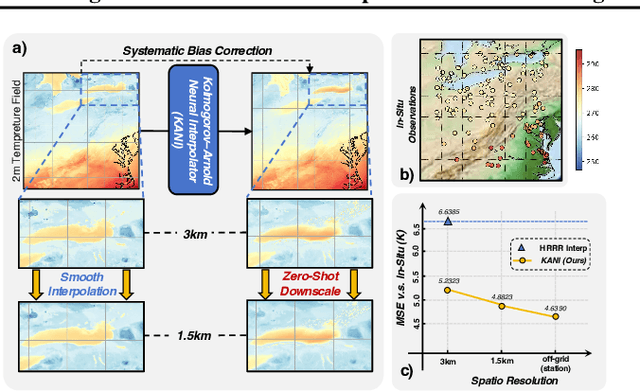

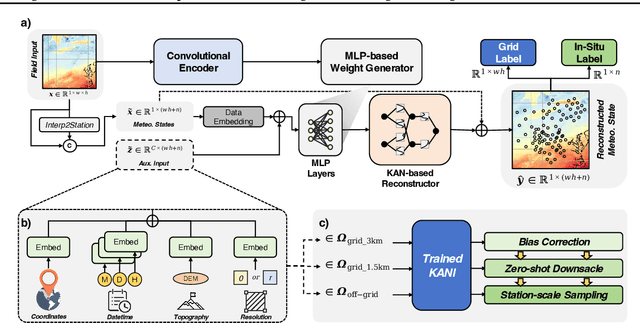
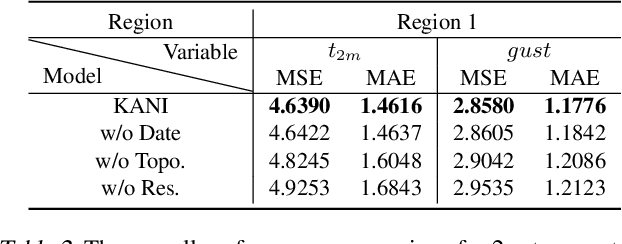
Abstract:Obtaining accurate weather forecasts at station locations is a critical challenge due to systematic biases arising from the mismatch between multi-scale, continuous atmospheric characteristic and their discrete, gridded representations. Previous works have primarily focused on modeling gridded meteorological data, inherently neglecting the off-grid, continuous nature of atmospheric states and leaving such biases unresolved. To address this, we propose the Kolmogorov Arnold Neural Interpolator (KANI), a novel framework that redefines meteorological field representation as continuous neural functions derived from discretized grids. Grounded in the Kolmogorov Arnold theorem, KANI captures the inherent continuity of atmospheric states and leverages sparse in-situ observations to correct these biases systematically. Furthermore, KANI introduces an innovative zero-shot downscaling capability, guided by high-resolution topographic textures without requiring high-resolution meteorological fields for supervision. Experimental results across three sub-regions of the continental United States indicate that KANI achieves an accuracy improvement of 40.28% for temperature and 67.41% for wind speed, highlighting its significant improvement over traditional interpolation methods. This enables continuous neural representation of meteorological variables through neural networks, transcending the limitations of conventional grid-based representations.
WSSM: Geographic-enhanced hierarchical state-space model for global station weather forecast
Jan 20, 2025Abstract:Global Station Weather Forecasting (GSWF), a prominent meteorological research area, is pivotal in providing timely localized weather predictions. Despite the progress existing models have made in the overall accuracy of the GSWF, executing high-precision extreme event prediction still presents a substantial challenge. The recent emergence of state-space models, with their ability to efficiently capture continuous-time dynamics and latent states, offer potential solutions. However, early investigations indicated that Mamba underperforms in the context of GSWF, suggesting further adaptation and optimization. To tackle this problem, in this paper, we introduce Weather State-space Model (WSSM), a novel Mamba-based approach tailored for GSWF. Geographical knowledge is integrated in addition to the widely-used positional encoding to represent the absolute special-temporal position. The multi-scale time-frequency features are synthesized from coarse to fine to model the seasonal to extreme weather dynamic. Our method effectively improves the overall prediction accuracy and addresses the challenge of forecasting extreme weather events. The state-of-the-art results obtained on the Weather-5K subset underscore the efficacy of the WSSM
RSRefSeg: Referring Remote Sensing Image Segmentation with Foundation Models
Jan 12, 2025


Abstract:Referring remote sensing image segmentation is crucial for achieving fine-grained visual understanding through free-format textual input, enabling enhanced scene and object extraction in remote sensing applications. Current research primarily utilizes pre-trained language models to encode textual descriptions and align them with visual modalities, thereby facilitating the expression of relevant visual features. However, these approaches often struggle to establish robust alignments between fine-grained semantic concepts, leading to inconsistent representations across textual and visual information. To address these limitations, we introduce a referring remote sensing image segmentation foundational model, RSRefSeg. RSRefSeg leverages CLIP for visual and textual encoding, employing both global and local textual semantics as filters to generate referring-related visual activation features in the latent space. These activated features then serve as input prompts for SAM, which refines the segmentation masks through its robust visual generalization capabilities. Experimental results on the RRSIS-D dataset demonstrate that RSRefSeg outperforms existing methods, underscoring the effectiveness of foundational models in enhancing multimodal task comprehension. The code is available at \url{https://github.com/KyanChen/RSRefSeg}.
 Add to Chrome
Add to Chrome Add to Firefox
Add to Firefox Add to Edge
Add to Edge